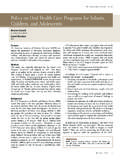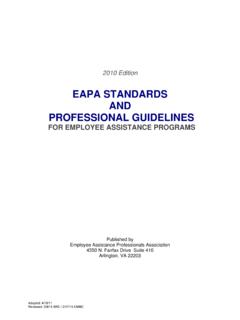Transcription of Guidelines for Periodontal Therapy - Pediatric Dentistry
1 REFERENCE MANUAL V 39 / NO 6 17 / 18. Guideline for Periodontal Therapy Originating Group American Academy of Periodontology Endorsed by the American Academy of Pediatric Dentistry 2003. Research has provided evidence that chronic inflammatory The goals of Periodontal Therapy are to preserve the Periodontal diseases are Studies have also been natural dentition, periodontium and peri-implant tissues; to directed at providing information to permit better understand- maintain and improve Periodontal and peri-implant health, ing of mechanisms of disease progression and pathogenesis in comfort, esthetics, and function. Currently accepted clinical order to make treatment of Periodontal diseases more effective signs of a healthy periodontium include the absence of inflam- and As a result of advances in knowledge and matory signs of disease such as redness, swelling, suppuration, Therapy , the great majority of patients retain their dentition over and bleeding on probing; maintenance of a functional perio- their lifetime with proper treatment, reasonable plaque control, dontal attachment level; minimal or no recession in the absence and continuing maintenance However, there are some of interproximal bone loss; and functional dental implants.
2 Situations when traditional Therapy is not effective in arresting the disease. In these instances, the progression of the disease Periodontal examination may be slowed, but eventually the teeth may be All patients should receive a comprehensive Periodontal Adherence to the following Guidelines will not guarantee examination. Such an examination includes discussion with a successful outcome and will not obviate all complications or the patient regarding the chief complaint, medical and dental postcare problems in Periodontal Therapy . Additionally, these history review, clinical examination, and radiographic analysis. Guidelines should not be deemed inclusive of all methods of Microbiologic, genetic, biochemical, or other diagnostic tests care, or exclusive of treatment reasonably directed at obtaining may also be useful, on an individual basis, for assessing the the same results.
3 It should also be noted that these Guidelines Periodontal status of selected patients or sites. Some or all of describe summaries of patient evaluation and treatment proce- the following procedures may be included in a comprehen- dures that have been presented in considerably more detail sive Periodontal examination: within textbooks of periodontology as well as in the medical 1. Extra- and intraoral examination to detect non- and dental literature. Ultimately judgments regarding the Periodontal oral diseases or conditions. appropriateness of any specific procedure must be made by 2. General Periodontal examination to evaluate the topo- the practitioner in light of all the circumstances presented by pography of the gingiva and related structures; to the individual patient. assess probing depth, recession, and attachment level.
4 To evaluate the health of the subgingival area with Scope of periodontics measures such as bleeding on probing and suppura- Periodontics is the specialty of Dentistry that encompasses pre- tion; to assess clinical furcation status; and to detect vention, diagnosis, and treatment of diseases of the supporting endodontic- Periodontal lesions. and surrounding tissues of teeth and dental implants. The 3. Assessment of the presence, degree and/or distribu- specialty includes maintenance of the health, function, and tion of plaque, calculus and gingival inflammation. esthetics of all supporting structures and tissues (gingiva, 4. Dental examination, including caries assessment, Periodontal ligament, cementum, alveolar bone, and sites for proximal contact relationships, the status of dental tooth replacements). Tissue regeneration, management of restorations and prosthetic appliances, and other Periodontal -endodontic lesions, and providing dental implants tooth- or implant-related problems.
5 As tooth replacements are, when indicated, integral components 5. Determination of the degree of mobility of teeth and of comprehensive Periodontal Therapy . Tooth extraction and dental implants. implant site development may accompany either Periodontal 6. Occlusal examination. or implant Therapy . Patient management during Therapy may 7. Interpretation of a satisfactory number of updated, include the administration of intravenous conscious sedation. diagnostic quality periapical and bite-wing radio- graphs or other diagnostic imaging needed for implant Therapy . Copyright 1993, 2000, 2001 by the American Academy of Periodontology. 8. Evaluation of potential Periodontal systemic inter- Copyrighted and reproduced with permission from the American Academy relationships. of Periodontolgy. Periodontal Therapy . J Periodontol 2001;72:1624-8.
6 9. Assessment of suitability to receive dental implants. 440 ENDORSEMENTS. AMERICAN ACADEMY OF Pediatric Dentistry . Establishing a diagnosis and prognosis 6. Consideration of diagnostic testing that may include The purpose of the comprehensive Periodontal examination microbiological, genetic or biochemical assessment or is to determine the Periodontal diagnosis and prognosis and/ monitoring during the course of Periodontal Therapy . or suitability for dental implants. This process includes an 7. Periodontal maintenance program. evaluation of Periodontal and peri-implant tissues to determine the suitability of the patient for treatments including non- Informed consent and patient records surgical, surgical, regenerative and reconstructive Therapy , or Where reasonably foreseeable risks, potential complications, or dental implant placement.
7 This information should be record- the possibility of failure are associated with treatment, informed ed in the patient's chart and communicated to the patient and consent should be obtained prior to the commencement of the referring dentist when appropriate. Therapy . The information given to the patient in these circum- stances should include the following: Periodontal diseases and conditions 1. The diagnosis, etiology, proposed Therapy , possible Diseases of the periodontium may be categorized as gingival alternative treatment(s), and the prognosis with and diseases, periodontitis, necrotizing Periodontal diseases, abs- without the proposed Therapy or possible alternatives. cesses of the periodontium, and developmental or acquired 2. Recommendations for referral to other health care deformities and Gingivitis is gingival inflam- providers as necessary.
8 Mation without attachment loss or with non-progressing 3. The reasonably foreseeable inherent risks and potential attachment loss. Other gingival diseases may be modified by complications associated with the proposed Therapy , systemic factors, medications or malnutrition. Periodontitis including failure with the ultimate loss of teeth or is gingival inflammation with progressing attachment loss. dental implants. Different forms include, but are not limited to, chronic 4. The need for Periodontal maintenance treatment periodontitis, aggressive periodontitis, periodontitis as a after active Therapy due to the potential for disease manifestation of systemic disease, necrotizing ulcerative recurrence. periodontitis, and periodontitis associated with endodontic A record of the patient's consent to the proposed Therapy lesions.
9 Periodontitis may be further characterized by degree should be maintained. Moreover, complete records of diagnosis, of attachment loss as slight, moderate, or severe; by extent treatment, results, and recommended follow-up are essential, as localized or generalized; and by post-treatment status starting with the initial examination and continuing for as long as recurrent or refractory. Facial recession involving loss of as the patient is under care. Where reasonably foreseeable risks, Periodontal attachment and gingival tissue affects children and potential complications, or the possibility of failure are associ- adults. The prevalence increases with age and adults over 50 ated with treatment, it is advisable to obtain the informed have the greatest degree of involvement. This mucogingival con-sent in writing prior to commencement of Therapy .
10 Condition is often Edentulous ridge defects result from loss of osseous tissue and can compromise esthetics or Treatment procedures complicate future implant placement. Other diseases and A broad range of therapies exist in periodontics. No single anomalies not explicitly described herein may also involve the treatment approach can provide the only means of treating any periodontium. one or all Periodontal diseases. One treatment modality may be appropriate for one section of the mouth while another Development of a treatment plan approach may be suitable at other sites. The clinical findings together with a diagnosis and prognosis When indicated, treatment should include: should be used to develop a logical plan of treatment in order 1. Patient education, training in personal oral hygiene, to eliminate or alleviate the signs and symptoms of Periodontal and counseling on control of risk factors ( , smo- diseases and thereby arrest or slow further disease progression.)















